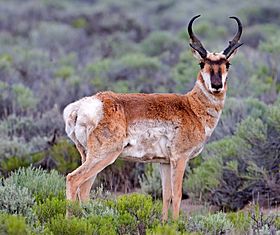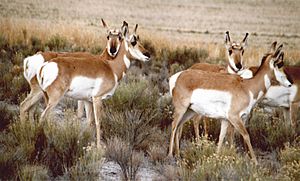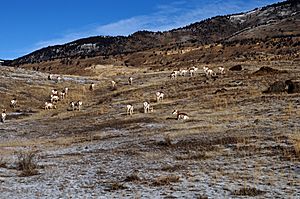Pronghorn facts for kids
Quick facts for kids Pronghorn |
|
|---|---|
 |
|
| A pronghorn near Fort Rock, Oregon | |
| Scientific classification | |
| Kingdom: | |
| Phylum: | |
| Class: | |
| Order: | |
| Suborder: | |
| Infraorder: | |
| Family: |
Antilocapridae
Gray, 1866
|
| Genus: |
Antilocapra
|
| Binomial name | |
| Antilocapra americana |
|
The pronghorn (Antilocapra americana) is a very fast mammal with hooves. It is the only living animal in its special family, called Antilocapridae. This mammal looks a bit like an antelope. It's about 1.3 to 1.5 meters (4 to 5 feet) long from nose to tail. It stands about 81 to 104 centimeters (2.5 to 3.5 feet) tall at its shoulder.
Pronghorns live in North America. They mostly live in the prairies. You can also find them in the desert and the Rocky Mountains.
Pronghorns are the fastest land mammals in the Western Hemisphere. They can run up to 88 kilometers per hour (55 mph). They are often called the second-fastest land animal, after the African cheetah. Pronghorns can keep up their high speeds for longer than cheetahs.
Large predators hunt pronghorns. These include cougars, wolves, coyotes, and bobcats. Golden eagles sometimes hunt young pronghorns and even adults.
Contents
What Pronghorns Look Like
The pronghorn has yellowish-brown to reddish-brown fur. Its underside is white. It also has white stripes on its neck and around its mouth. Male pronghorns have black markings on their neck and face.
Male pronghorns have horns that can be up to 25 centimeters long. Female pronghorns usually do not have horns. If they do, their horns are very short.
Pronghorn Life and Habits
Pronghorns can be active at any time, day or night. However, they are most active around dawn and dusk. Pronghorns eat grass, but they also munch on leaves and herbs. They can even digest poisonous plants. This is because they have a large liver that helps filter out toxins.
Reproduction and Life Cycle
In summer, adult male pronghorns fight other males for their territory. In this territory, the male keeps a group of females. He mates with them in September. Males fight hard to win over females. They can even injure each other seriously.
Young males that are not yet strong enough to fight for territory form small groups. Old, weak males often live alone. Females live in groups of about 20 animals. When a female is about to give birth, she leaves her group for a short time.
After a pregnancy of about 8 and a half months, the female gives birth. She usually has 1 or 2 young, but sometimes three. The new-borns hide for about three days. After a week, they can run with their mother. A baby pronghorn has grey fur. After three months, it gets its adult coloring. They drink milk for 5 to 6 months. They start eating grass after three weeks. Females become mature when they are about 15 to 16 months old. Males become mature when they are 24 months old.
Where Pronghorns Live

Scientists first learned about pronghorns during the Lewis and Clark Expedition. They found them in what is now South Dakota. Pronghorns live from southern Saskatchewan and Alberta in Canada. Their range goes south through the United States. This includes southwestern Minnesota and central Texas. It stretches west to coastal southern California. They also live in northern Baja California Sur, Sonora, and San Luis Potosí in northern Mexico.
There are different types of pronghorns, called subspecies. The Sonoran pronghorn (A. a. sonoriensis) lives in Arizona and Mexico. Other subspecies include the Mexican pronghorn (A. a. mexicana), the Oregon pronghorn (A. a. oregona), and the very rare Baja California pronghorn (A. a. peninsularis).
How Pronghorns Were Saved

Pronghorns were once hunted almost to extinction. But many people cared about them and helped save them. On January 26, 1931, President Herbert Hoover signed an order to create a safe place for them. Then, on December 31, 1936, President Franklin Roosevelt signed another order. This created a large area of about 222,000 hectares (549,000 acres) for pronghorns. This was a big step in helping pronghorns recover in North America.
Images for kids
-
Pronghorns in Montana
-
Male adult pronghorn in Yellowstone National Park
See also
 In Spanish: Antílope americano para niños
In Spanish: Antílope americano para niños




